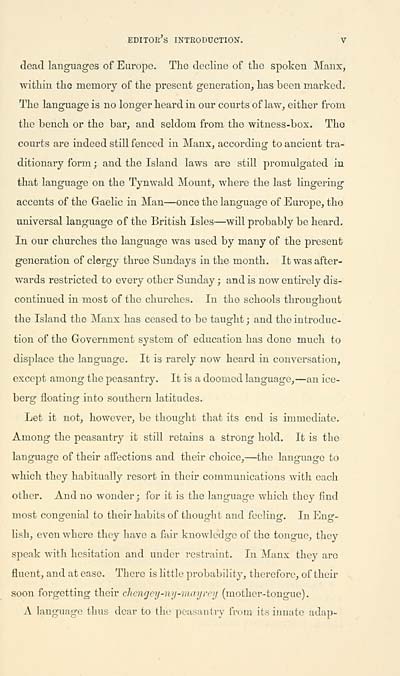Blair Collection > Practical grammar of the antient Gaelic, or, Language of the Isle of Man, usually called Manks
(9)
Download files
Complete book:
Individual page:
Thumbnail gallery: Grid view | List view

EDITOR S INTRODUCTION. V
dead languages of Europe. The decline of the spoken Manx,
witliin the memory of the present generation^ has been marked.
The language is no longer heard in our courts of law, either from
the bench or the bar, and seldom from the witness-box. The
courts are indeed still fenced in Manx, according to ancient tra-
ditionary form ; and the Island laws are still promulgated in
that language on the Tynwald Mount, where the last lingering
accents of the Graelic in Man — once the language of Europe, the
universal language of the British Isles — will probably be heard.
In our churches the language was used by many of the present
generation of clergy three Sundays in the month. It was after-
wards restricted to every other Sunday ; and is now entirely dis-
continued in most of the churches. In the schools throughout
the Island the Manx has ceased to be taught; and the introduc-
tion of the Government system of education has done much to
displace the language. It is rarely now heard in conversation,
except among the peasantry. It is a doomed language, — an ice-
berg floating into southern latitudes.
Let it not, however, be thought that its end is immediate.
Among the peasantry it still retains a strong hold. It is the
language of their affections and their choice, — the language to
which they habitually resort in their communications with each
other. And no wonder ; for it is the language which they find
most congenial to their habits of thought and feeling. In Eng-
lish, even where they have a fair knowledge of the tongue, they
speak with hesitation and under restraint. In Manx they arc
fluent, and at ease. There is little probability, therefore, of their
soon forgetting their chengeij-ny-mayvey (mother- tongue).
A language thus dear to the peasantry from its innate adap-
dead languages of Europe. The decline of the spoken Manx,
witliin the memory of the present generation^ has been marked.
The language is no longer heard in our courts of law, either from
the bench or the bar, and seldom from the witness-box. The
courts are indeed still fenced in Manx, according to ancient tra-
ditionary form ; and the Island laws are still promulgated in
that language on the Tynwald Mount, where the last lingering
accents of the Graelic in Man — once the language of Europe, the
universal language of the British Isles — will probably be heard.
In our churches the language was used by many of the present
generation of clergy three Sundays in the month. It was after-
wards restricted to every other Sunday ; and is now entirely dis-
continued in most of the churches. In the schools throughout
the Island the Manx has ceased to be taught; and the introduc-
tion of the Government system of education has done much to
displace the language. It is rarely now heard in conversation,
except among the peasantry. It is a doomed language, — an ice-
berg floating into southern latitudes.
Let it not, however, be thought that its end is immediate.
Among the peasantry it still retains a strong hold. It is the
language of their affections and their choice, — the language to
which they habitually resort in their communications with each
other. And no wonder ; for it is the language which they find
most congenial to their habits of thought and feeling. In Eng-
lish, even where they have a fair knowledge of the tongue, they
speak with hesitation and under restraint. In Manx they arc
fluent, and at ease. There is little probability, therefore, of their
soon forgetting their chengeij-ny-mayvey (mother- tongue).
A language thus dear to the peasantry from its innate adap-
Set display mode to: Large image | Transcription
Images and transcriptions on this page, including medium image downloads, may be used under the Creative Commons Attribution 4.0 International Licence unless otherwise stated. ![]()
| Early Gaelic Book Collections > Blair Collection > Practical grammar of the antient Gaelic, or, Language of the Isle of Man, usually called Manks > (9) |
|---|
| Permanent URL | https://digital.nls.uk/81513530 |
|---|
| Description | A selection of books from a collection of more than 500 titles, mostly on religious and literary topics. Also includes some material dealing with other Celtic languages and societies. Collection created towards the end of the 19th century by Lady Evelyn Stewart Murray. |
|---|
| Description | Selected items from five 'Special and Named Printed Collections'. Includes books in Gaelic and other Celtic languages, works about the Gaels, their languages, literature, culture and history. |
|---|

